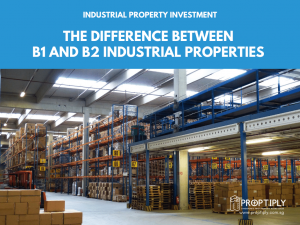
When it comes to industrial property investment in Singapore, there are two types of industrial property that you need to be aware of. These are B1 and B2 industrial properties.
It is important to know the difference between these two types of industrial properties so that you know what type of businesses are allowed in the premises.
You must also take note of the 60:40 allowable use ratio. This 60:40 rule means that at least 60% of the gross space or total floor are of the industrial property must be used for industrial activity. The remaining 40% of the gross space can be used for ancillary (supporting) purposes.
Now, let’s dive into the differences between B1 and B2 industrial property.
B1 industrial property
What is a B1 industrial property?
B1 industrial properties are earmarked for clean and light industries. Generally, these types of industries do not generate much noise.
Therefore, the National Environment Agency (NEA) has imposed a 50m nuisance buffer from a B1 zone to the surrounding areas. Industrial activities that have a nuisance buffer greater than 50m (i.e., likely to generate greater noise from their activities) are not allowed to be located in B1 industrial properties.
What are the types of activities allowed in B1 industrial properties?
According to the 60:40 rule, at least 60% of a B1 industrial property must be used for industrial activity. These allowable activities include:
- Light manufacturing
- Printing or publishing
- Industrial training
- Food packing
- E-businesses including telecommunications, data centres, internet service providers, software development, call centres
- Core media activities such as pre-production, production, post-production and distribution activities; as well as network programming.
The remaining (maximum) 40% of space in a B1 industrial property can be used for ancillary purposes. These may include:
- Ancillary offices
- Meeting rooms
- Showrooms
- Childcare centre
- Industrial canteen
- Workers’ dormitory
- Ancillary display area
B2 industrial property
What is a B2 industrial property?
B2 industrial properties are only for general and special industries that are involved in heavier manufacturing and production, assembly, repair and servicing, amongst others.
These activities usually cause greater noise or air pollution. Because of this greater environmental impact, there is a 100m nuisance buffer imposed from B2 zones to the surrounding area. That’s why B2 industrial zones are usually not located near residential areas.
What are the types of activities allowed in B2 industrial properties?
Similar to B1 industrial properties, B2 industrial properties also have to observe the 60:40 rule. At least 60% of the B2 industrial property must be used for industrial activities. These allowable activities may include:
- Manufacturing (general industry)
- Production
- Repair and servicing
- Assembly
- Storage of chemicals or oils
- Knitting mills
- Industrial training
- Core media activities such as pre-production, production, post-productino and distribution activities, as well as network programming
- E-businesses such as telecommunications, data centres, internet service providers, software development, call centres.
The remaining (maximum) 40% of space in a B2 industrial property that can be used for ancillary purposes can be used for the following:
- Ancillary offices
- Meeting rooms
- Sick rooms
- Diesel and pump points
- M&E services
- Showrooms
- Childcare centre
- Industrial canteen
- Selected commercial uses
What are the key differences between B1 and B2 industrial properties and why should you know them?
Basically, B1 industrial properties can only be used for clean and light activities, while B2 industrial properties are for heavier manufacturing or production activities.
B1 industrial properties therefore have a lower noise levels and a nuisance buffer of 50m. As such they can be located nearer to residential properties On the other hand, B2 industrial properties have a higher nuisance buffer of 100m and therefore need to be located further away from residential areas.
As a landlord, it is important to distinguish between B1 and B2 industrial properties so that you know what type of activities can be allowed in your property. That way, you can ensure that your tenant is involved in the nature of business that is allowed for the type of industrial property you have acquired. This will avoid costly mistakes and ensure that you only lease out your property to suitable tenants.